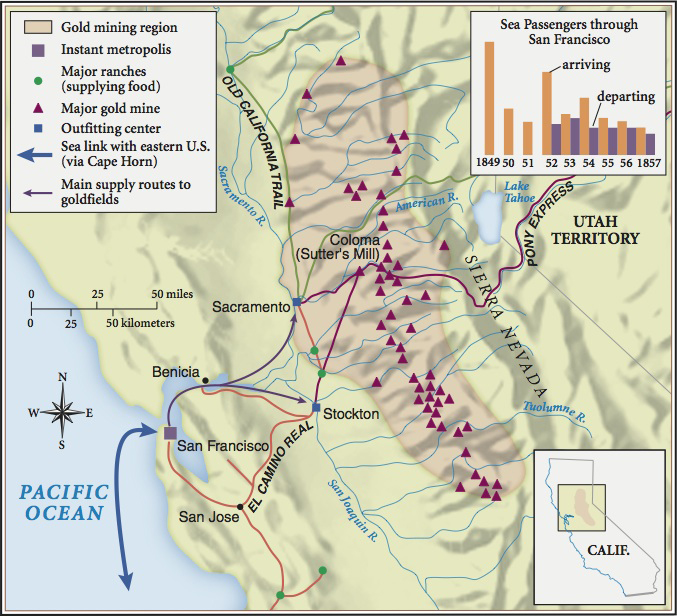Historical Background
Alta California, as it was known under the rule of Spain (1769–1821) and Mexico (1821–46), had diverse connections around the Pacific well before the gold rush. One thousand ships flying at least twenty distinct flags arrived on the California coast between the 1770s and 1848. Although most of these ships originated in Atlantic ports, once in the Pacific they plied the coastlines of North and South America, frequently stopping in Hawai‘i or other islands; many ventured on to the major port of Canton, China. In California, ship captains sought a variety of trade items, including sea otter pelts, cattle hides and tallow, and basic food supplies for their long voyages. Thus, California was well known to traders, ship captains, and common sailors long before the U.S.-Mexico War (1846–48) or the discovery of gold.
News of James Marshall’s gold strike on the American River spread quickly throughout California, north and south along the Pacific coastline, and then across the Pacific wherever outbound ships reached port. U.S. President James K. Polk would not make the historic announcement to Congress until early December 1848, thus confirming the rumors already circulating in East Coast port cities. By this time, thousands of hopeful miners had arrived in California from Mexico, Peru, Chile, Hawai’i, and other places around the Pacific. Americans, who soon poured in by the tens of thousands via overland or sea routes, were joined by thousands of European and Chinese miners.
The international nature of the gold rush ensured that California would be a cosmopolitan and diverse region. But social relations between groups in the new state were rarely peaceful or happy. Mexican and Chinese miners faced particular hostility. In fact, a good portion of the state’s revenues in the 1850s derived from a series of “foreign miner’s” taxes targeting the Chinese in particular. White Californians, few of whom made their expected fortune in the mines, often violently attacked Chinese and Mexican immigrants. Conflict and intense competition marked California’s early years as a state, even motivating some individuals (such as the King of Hawai’i, Kamehameha) to warn friends against venturing to that distant land.
Timeline
| January 1848 | James Marshall, an employee of John Sutter, finds gold on the South Fork of the American River. |
| February 1848 | Treaty of Guadalupe Hidalgo signed between U.S. and Mexico, ending the U.S.-Mexico War and granting control of California to the United States. |
| April 1848 | The Pacific Mail Steamship Company is founded in New York City to deliver mail to California under U.S. government contract. |
| June 1848 | News of the California gold rush published in a Honolulu newspaper, the Polynesian. |
| Summer 1848 | Reports of the gold rush reach the Chinese port of Canton; merchants begin sending ships with supplies and hopeful miners to California. |
| December 1848 | U.S. President James K. Polk, in his State of the Union Address, confirms widespread reports of major gold deposits in California. |
| 1849 | Multitudes of “49ers” arrive by land and sea in California and make their way to the Sierra foothills. |
| September 1850 | California admitted to the union as the thirty-first state. |
| 1850 | More than 100,000 have migrated to California. |
| November 1851 | The clipper ship Flying Cloud arrives in San Francisco from New York in only 89 days, the fastest voyage to date on record. |
| 1853 | Hydraulic mining overtakes placer mining and primary means of extracting gold. |
